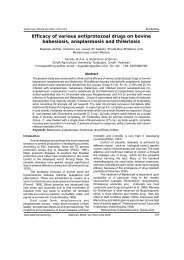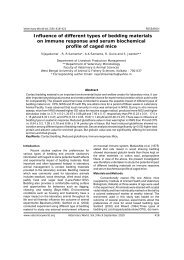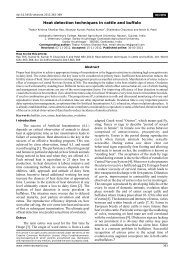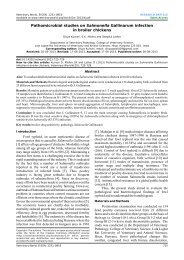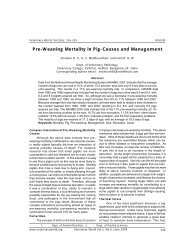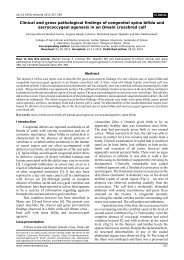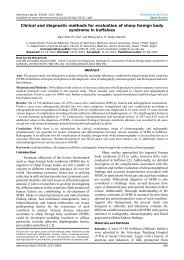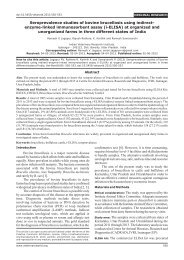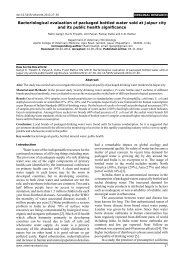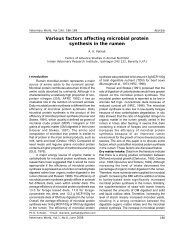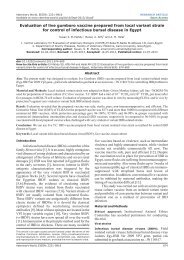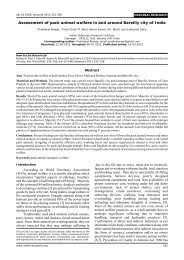Involvement of fungal species in bovine mastitis ... - Veterinary World
Involvement of fungal species in bovine mastitis ... - Veterinary World
Involvement of fungal species in bovine mastitis ... - Veterinary World
You also want an ePaper? Increase the reach of your titles
YUMPU automatically turns print PDFs into web optimized ePapers that Google loves.
doi:10.5455/vetworld.2013.393-395<br />
<strong>Involvement</strong> <strong>of</strong> <strong>fungal</strong> <strong>species</strong> <strong>in</strong> bov<strong>in</strong>e <strong>mastitis</strong> <strong>in</strong> and<br />
around Mathura, India<br />
Sarita Pachauri, Puneet Varshney, Sandeep Kumar Dash and Manoj Kumar Gupta<br />
Department <strong>of</strong> Microbiology and Immunology<br />
Pandit Deen Dayal Upadhyaya Veter<strong>in</strong>ary and Animal Sciences University, Mathura, UP, India<br />
Correspond<strong>in</strong>g author: Sandeep Kumar Dash, email:sandeepkumar.dash@gmail.com<br />
Received: 04-11-2012, Accepted: 13-12-2013, Published onl<strong>in</strong>e: 12-04-2013<br />
How to cite this article:<br />
Pachauri S, Varshney P, Dash SK and Gupta MK (2013) <strong>Involvement</strong> <strong>of</strong> <strong>fungal</strong> <strong>species</strong> <strong>in</strong> bov<strong>in</strong>e <strong>mastitis</strong> <strong>in</strong> and around<br />
Mathura, India, Vet <strong>World</strong> 6(7):393-395, doi:10.5455/vetworld.2013.393-395<br />
Abstract<br />
Aim: To study the prevalence <strong>of</strong> mycotic <strong>mastitis</strong> <strong>in</strong> bov<strong>in</strong>es <strong>of</strong> Mathura region.<br />
Materials and Methods: A total <strong>of</strong> 100 milk samples collected from seven different regions <strong>of</strong> Mathura were exam<strong>in</strong>ed by<br />
cultural, morphological and biochemical methods.<br />
Results: Out <strong>of</strong> 100 milk samples processed 64 samples were found positive for <strong>fungal</strong> isolates. The most common isolates<br />
were Candida albicans, Aspergillus fumigatus and Aspergillus niger.<br />
Conclusion: The results <strong>of</strong> the present study suggest that Candida spp and Aspergillus spp are the ma<strong>in</strong> fungi <strong>in</strong>volved <strong>in</strong><br />
bov<strong>in</strong>e <strong>mastitis</strong> <strong>in</strong> this region. Good hygiene and sanitation practices <strong>of</strong> animal farm and judicious use <strong>of</strong> antibiotics will lower<br />
<strong>in</strong>cidence <strong>of</strong> bov<strong>in</strong>e mycotic <strong>mastitis</strong>.<br />
Keywords: Aspergillus, bov<strong>in</strong>e, candida, fungus, <strong>mastitis</strong>, Mathura<br />
Introduction very little work is done <strong>in</strong> India. Present study was<br />
Mastitis is the <strong>in</strong>flammation <strong>of</strong> the mammary<br />
gland. It is widespread <strong>in</strong> dairy herds and associated<br />
with a significant reduction <strong>in</strong> milk yield result<strong>in</strong>g <strong>in</strong><br />
undertaken to know the prevalence <strong>of</strong> <strong>fungal</strong> <strong>in</strong>fections<br />
and the <strong>species</strong> <strong>in</strong>volved <strong>in</strong> cl<strong>in</strong>ical and sub-cl<strong>in</strong>ical<br />
<strong>mastitis</strong>.<br />
<strong>in</strong>creased costs <strong>of</strong> production and deteriorated quality<br />
<strong>of</strong> milk and milk products [1]. Mastitis is characterized<br />
by partial or complete damage to udder tissues which is<br />
usually a consequence <strong>of</strong> microbial <strong>in</strong>fection. A wide<br />
variety <strong>of</strong> microorganisms have been implicated as<br />
causative agent <strong>of</strong> bov<strong>in</strong>e <strong>mastitis</strong> <strong>in</strong>clud<strong>in</strong>g bacteria<br />
and fungi [2].<br />
Seriousness <strong>of</strong> mycotic <strong>in</strong>fection <strong>of</strong> mammary<br />
glands depends upon the <strong>species</strong> <strong>of</strong> the fungus <strong>in</strong>volved<br />
as well as the percentage <strong>of</strong> <strong>in</strong>fectivity. Treatment <strong>of</strong><br />
mycotic <strong>mastitis</strong> is a challenge as many <strong>of</strong> these fungi<br />
do not respond to the antibiotics therapy rather they use<br />
some <strong>of</strong> the antibiotics like tetracycl<strong>in</strong>e as their source<br />
<strong>of</strong> energy [3].<br />
In rout<strong>in</strong>e <strong>mastitis</strong> therapy antibiotics are used<br />
more <strong>of</strong>ten and much emphasis is not given on the<br />
anti<strong>fungal</strong> therapy. Due to this reason most <strong>of</strong> the<br />
<strong>mastitis</strong> cases not only become <strong>in</strong>curable but also act as<br />
a source <strong>of</strong> <strong>in</strong>fection for other lactat<strong>in</strong>g animals <strong>in</strong> the<br />
herd. Therefore it has become necessary to know about<br />
the <strong>fungal</strong> spp. play<strong>in</strong>g role <strong>in</strong> <strong>mastitis</strong>, which could be<br />
differentially diagnosed and p<strong>in</strong>po<strong>in</strong>t therapy should<br />
be given to the animals.<br />
Though there are many reports <strong>of</strong> <strong>fungal</strong><br />
<strong>in</strong>volvement <strong>in</strong> bov<strong>in</strong>e <strong>mastitis</strong> around the globe, still<br />
Materials and Methods<br />
A total <strong>of</strong> 100 milk samples were collected for<br />
<strong>fungal</strong> isolation from March to May 2010 (Table-1).<br />
Out <strong>of</strong> these 20 milk samples were collected from<br />
cl<strong>in</strong>ical <strong>mastitis</strong> cases and 80 milk samples were<br />
collected from apparently healthy cows and buffaloes.<br />
15ml <strong>of</strong> milk was collected from each animal and<br />
transported to laboratory under ice. Milk samples were<br />
exam<strong>in</strong>ed for colour, consistency and pH. Samples<br />
were streaked on Saboraud's dextrose agar plates. The<br />
plates were <strong>in</strong>cubated at 37°C and exam<strong>in</strong>ed for growth<br />
at 24, 48 and 72 hours and at weekly <strong>in</strong>tervals for 4<br />
weeks after which the plates show<strong>in</strong>g no growth were<br />
considered negative [3]. The colonies were picked up<br />
and re-streaked on another SDA plate to get the pure<br />
cultures. These <strong>fungal</strong> isolates were studied for their<br />
cultural and morphological characteristics. The<br />
morphological characteristics were noted after sta<strong>in</strong><strong>in</strong>g<br />
with Gram's and Lacto phenol cotton blue sta<strong>in</strong>.<br />
Isolates were identified by different sugar fermentation<br />
test. Briefly, 1% solution <strong>of</strong> different sugar solutions<br />
were dispensed <strong>in</strong>to separate tubes and <strong>fungal</strong> isolates<br />
were <strong>in</strong>oculated <strong>in</strong> these tubes. The tubes were then<br />
o<br />
<strong>in</strong>cubated at 37 C for 24-48 hours. The results were<br />
<strong>in</strong>dicated by the change <strong>of</strong> colour [4].<br />
This article is an open access article licensed under the terms <strong>of</strong> the<br />
Creative Commons Attribution License (http://creativecommons.<br />
org/licenses/by/2.0) which permits unrestricted use, distribution<br />
and reproduction <strong>in</strong> any medium, provided the work is properly cited.<br />
Results<br />
Out <strong>of</strong> 100 samples, 64 samples (14 from cl<strong>in</strong>ical<br />
www.veter<strong>in</strong>aryworld.org 393
Table-1. Samples collected from different places<br />
doi:10.5455/vetworld.2013.393-395<br />
Sr. No. Milk Samples Total Areas No. <strong>of</strong> samples<br />
1. Cl<strong>in</strong>ical Samples 20 Kothari Hospital Veter<strong>in</strong>ary University, Mathura 20<br />
2. Subcl<strong>in</strong>ical samples 80 Haridayal Goshala,Vr<strong>in</strong>davan 10<br />
Shriji baba Goshala,Mathura 10<br />
Panchayanti Goshala, Raman Reti 20<br />
DDD Farm-Mathura 20<br />
Krishna farm-Mathura 10<br />
Daudayal farm-Baldeo Mathura 10<br />
Total 100 100<br />
Table-2. Species wise isolation from different samples<br />
Sr. No. Type <strong>of</strong> sample Total no <strong>of</strong> Sample No. positive for Species isolated No. <strong>of</strong> isolates Percentage<br />
fungus isolation <strong>in</strong>fectivity<br />
1 Cl<strong>in</strong>ical 20 14 Candida albicans 6 30<br />
Asprgillus fumigatus 3 15<br />
Aspergillus niger 5 25<br />
2 Subcl<strong>in</strong>ical 80 50 Candida albicans 20 25<br />
Asprgillus fumigatus 14 17.5<br />
Aspergillus niger 16 20<br />
cases and 50 from subcl<strong>in</strong>ical cases), were found A higher percentage <strong>of</strong> isolation <strong>of</strong> fungi from<br />
positive for <strong>fungal</strong> isolation. Of the 64 isolates, 26 cl<strong>in</strong>ical cases and subcl<strong>in</strong>ical cases reveal that the<br />
isolates yielded smooth white or yellowish, cottony <strong>in</strong>cidence <strong>of</strong> <strong>fungal</strong> <strong>mastitis</strong> is <strong>in</strong>creas<strong>in</strong>g which may be<br />
colonies hav<strong>in</strong>g resemblance with Candida spp. Upon due to unhygienic conditions <strong>of</strong> the animal sheds<br />
microscopic exam<strong>in</strong>ation these isolates showed oval- support<strong>in</strong>g the growth <strong>of</strong> <strong>fungal</strong> spores and hyphae <strong>in</strong><br />
shaped budd<strong>in</strong>g cells. Sugar fermentation test revealed the vic<strong>in</strong>ity <strong>of</strong> lactat<strong>in</strong>g animals. Thereby, <strong>in</strong>creas<strong>in</strong>g<br />
that the isolates can ferment glucose, maltose and the probability <strong>of</strong> <strong>fungal</strong> spores and yeast cells to enter<br />
trehalose but cannot ferment lactose and sucrose. <strong>in</strong>to the udder parenchyma which provides the best<br />
These 26 isolates were tentatively identified as environment for the growth <strong>of</strong> these fungi [22,23]. It<br />
Candida albicans [5]. may be due to the development <strong>of</strong> antibiotic resistance<br />
Rema<strong>in</strong><strong>in</strong>g 38 isolates yielded rapidly grow<strong>in</strong>g <strong>in</strong> the bacteria which prolongs the course <strong>of</strong> treatment<br />
colonies with green or black pigmentation, show<strong>in</strong>g favor<strong>in</strong>g chances for the <strong>fungal</strong> <strong>species</strong> such as<br />
resemblance with Aspergillus spp. Out <strong>of</strong> 38 isolates Candida and Aspergillus to <strong>in</strong>fect as secondary<br />
17, revealed granular to cottony colony, septate <strong>in</strong>vader, due to the physiological changes <strong>in</strong> udder and<br />
mycelium with their conidiophores long and have club- milk. There may be the seasonal <strong>in</strong>fluences like high<br />
shaped vesicles. Vesicles were uniseriate and only the humidity along with favorable ambient temperature.<br />
distal half was covered by conidia. These 17 isolates Besides management practice like bath<strong>in</strong>g <strong>of</strong> animals<br />
were identified as Aspergillus fumigatus. Rest 21 <strong>of</strong> <strong>in</strong> polluted Yamuna river may be contributory. Other<br />
Aspergillus spp. revealed long non-septate conidio- practices like discard<strong>in</strong>g first few streaks <strong>of</strong> milk on<br />
phore with black spore heads with rapidly grow<strong>in</strong>g ground while milk<strong>in</strong>g may be contribut<strong>in</strong>g factor <strong>in</strong> the<br />
colonies. Vesicle was obscured due to pr<strong>of</strong>use conidiation. <strong>in</strong>creased <strong>in</strong>cidences <strong>of</strong> <strong>fungal</strong> <strong>mastitis</strong>. Further<br />
These 21 isolates were tentatively identified as detailed <strong>in</strong>vestigation on the mycotic and bacterial<br />
Aspergillus niger (Table-2) [6]. <strong>mastitis</strong> is required <strong>in</strong> relation to the hygienic and<br />
Discussion<br />
management practices as well as pattern <strong>of</strong> antibiotic<br />
therapy adopted for the treatment <strong>of</strong> these cases.<br />
Fungi as an etiological agent <strong>of</strong> <strong>mastitis</strong> have also<br />
been reported by various workers [7-12]. Prevalence <strong>of</strong><br />
Authors’ contribution<br />
Candida albicans <strong>in</strong> cl<strong>in</strong>ical and subcl<strong>in</strong>ical cases was All the authors contributed equally for this study. All<br />
found to be 30% and 25% (Table-2). The overall authors read and approved the f<strong>in</strong>al manuscript.<br />
<strong>in</strong>fectivity <strong>of</strong> Candida albicans was 26%. Other<br />
researchers have also reported Candida spp as a<br />
causative agent <strong>of</strong> bov<strong>in</strong>e <strong>mastitis</strong> [13-18]. This higher<br />
rate <strong>of</strong> Candida <strong>in</strong>fectivity may be due to the summer.<br />
Prevalence <strong>of</strong> Aspergillus spp <strong>in</strong> cl<strong>in</strong>ical and<br />
Acknowledgements<br />
Authors are thankful to the University authorities<br />
for provid<strong>in</strong>g necessary facilities to carry out this<br />
research work.<br />
subcl<strong>in</strong>ical cases was found to be 40% and 37.5%<br />
(Table 2). The overall <strong>in</strong>fectivity <strong>of</strong> Aspergillus spp<br />
was 38%. Other researchers have also reported<br />
Compet<strong>in</strong>g <strong>in</strong>terests<br />
Authors declare that they have no compet<strong>in</strong>g <strong>in</strong>terest.<br />
Aspergillus spp as a causative agent <strong>of</strong> bov<strong>in</strong>e <strong>mastitis</strong><br />
[19-21]. As Aspergillus spp. is a common pathogen <strong>of</strong><br />
human sk<strong>in</strong> this high <strong>in</strong>cidence <strong>of</strong> may be attributed to<br />
possible transmission dur<strong>in</strong>g milk<strong>in</strong>g.<br />
References<br />
1. Arshad, M., Qamar, F. K., Afzal, H. and Sidique, M. (1998)<br />
Epidemiological studies <strong>of</strong> bovive <strong>mastitis</strong> <strong>in</strong> district<br />
Gujarat. Proc. Intern. Sem<strong>in</strong>ar on Microbial Disease <strong>of</strong><br />
www.veter<strong>in</strong>aryworld.org 394
doi:10.5455/vetworld.2013.393-395<br />
Livestock and Poultry, CVS, Lahore, pp: 23. J., Sanches, E. M. C., Valente, P. and Ferreiro, L. (2008)<br />
2. Krukowski, H., Lisowski, A., Ròzanski, P. and Skórka, A. Diversity <strong>of</strong> yeasts from bov<strong>in</strong>e <strong>mastitis</strong> <strong>in</strong> southern Brazil.<br />
(2006) Yeasts and algae isolated from cows with <strong>mastitis</strong> <strong>in</strong> Revista Iberoamericana de Micología, 25: 154-156.<br />
the south-eastern part <strong>of</strong> Poland. Polish J Vet Sci, 9: 181-184. 15. Santos, R. C. and Mar<strong>in</strong>, J. M. (2005) Isolation <strong>of</strong> Candida<br />
3. Tarfarosh, M. A. and Purohit, S. K. (2008) Isolation <strong>of</strong> spp.from mastitic bov<strong>in</strong>e milk <strong>in</strong> Brazil. Mycopathologia,<br />
Candida spp. from Mastitic cows and Milkers. Vet. Scan, 3: 14-18. 159:251-253.<br />
4. Bhatia, R. and Ichhpujani, R.L. (2004) Essentials <strong>of</strong> Medical 16. Abd El-Razik, K. A., Abdelrahman, K. A., Abd El-Moez, S. I.<br />
Microbiology. 3rd Edition, Jaypee Brothers Medical and Danial, . E. N., (2011) New approach <strong>in</strong> diagnosis and<br />
Publishers (P) Ltd., New Delhi. treatment <strong>of</strong> Bov<strong>in</strong>e Mycotic Mastitis Egypt. African<br />
5. Stanojevic, S. and Krnjajic D. (2002) Yeast <strong>mastitis</strong> <strong>in</strong> cows. Journal <strong>of</strong> Microbiology Research, 5(31): 5725-5732.<br />
Internet journal <strong>of</strong> Food Safety, Vol.1. pp. 8 - 10. 17. Seker E (2010) Identification <strong>of</strong> Candida <strong>species</strong> isolated<br />
6. Morphology <strong>of</strong> Medically Important Fungi, 2nd Edition- from bov<strong>in</strong>e mastitic milk and their <strong>in</strong> vitro hemolytic<br />
http://labmed.ucsf.edu/education/residency/fung_morph/la activity <strong>in</strong> western Turkey. Mycopathologia, 169: 303-308.<br />
unchpage.html, Retrieved on 03-11-2012. 18. Dworecka-Kaszak, B., Krutkiewicz, A., Szopa, D.,<br />
7. Costa, E. O., Ribeiro, A. R., Watanabe, E. T. and Melville, P. Kleczkowski, M., and Biegańska, M. (2012) High<br />
A. (1998) Infectious bov<strong>in</strong>e <strong>mastitis</strong> caused by environ- Prevalence <strong>of</strong> Candida Yeast <strong>in</strong> Milk Samples from Cows<br />
mental organisms. J Vet Med B, 45(2): 65-71. Suffer<strong>in</strong>g from Mastitis <strong>in</strong> Poland, The Scientific <strong>World</strong><br />
8. Gaudie, C. M., Wragg, P.N. and Barber, A. M. (2009) Journal, vol. 2012, Article ID 196347. doi:10.1100/2012/<br />
Outbreak <strong>of</strong> disease due to Candida krusei <strong>in</strong> a small dairy 196347.<br />
herd <strong>in</strong> the UK. Veter<strong>in</strong>ary Record, 165: 535-537. 19. Blowey, R. and Edmondson, P. Mastitis control <strong>in</strong> dairy<br />
9. Türkyılmaz, S. and Kaynarca, S. (2010) The Slime<br />
nd<br />
herds, 2 edition. (2010) CAB <strong>in</strong>ternational, Cambridge,<br />
Production by Yeasts Isolated from Subcl<strong>in</strong>ical Mastitic MA, 02139, USA, p- 55.<br />
Cows. Acta Vet Brno,79: 581-586.doi: 10.2754/avb201079 20. Mdegela, R. H., Karimuribo, E., Kusiluka, L. J. M., Kabula,<br />
040581. B., Manjurano, A., Kapaga, A. M. and Kambarage, D. M.,<br />
10. Zaragoza, C. S., Olivares, R. A. C., Watty, A. E. D., (2005) Mastitis <strong>in</strong> smallholder dairy and pastoral cattle herds<br />
Moctezuma, A. D. P. and Tanaca, L. V. (2011) Yeasts <strong>in</strong> the urban and peri-urban areas <strong>of</strong> the Dodoma<br />
isolation from bov<strong>in</strong>e mammary glands under different municipality <strong>in</strong> Central Tanzania. Livestock Research for<br />
<strong>mastitis</strong> status <strong>in</strong> the Mexican High Plateu. Rev Iberoam Rural Development, Vol. 17, Article #123.<br />
Micol, 28(2):79-82. 21. Stephan, R., Senczek, D., Muller, C. and Feusi, C. (2000)<br />
11. Ranjan, R., Gupta, M. K. and S<strong>in</strong>gh, K. K. (2011) Study <strong>of</strong> Isolierung von Listeria spp. and Aspergillus fumigatus-zwei<br />
bov<strong>in</strong>e <strong>mastitis</strong> <strong>in</strong> different climatic conditions <strong>in</strong> Jharkhand, Fallberichte aus der Mastitisdiagnostik.Schweiz. Arch.<br />
India. Vet <strong>World</strong>, 4 (5), 205-208. doi:10.5455/vetworld. Tierheilkd, 142:387–390.<br />
2011.205-20. 22. Elad, D., Shpigel, N. Y., W<strong>in</strong>kler, M., Kl<strong>in</strong>ger, I., Fuchs, V.,<br />
12. Lagneau PE, Lebtani K and Sw<strong>in</strong>ne D. (1996) Isolation <strong>of</strong> Saran, A. et al. (1995) Feed contam<strong>in</strong>ation with Candida<br />
yeast from bov<strong>in</strong>e milk <strong>in</strong> Belgium. Mycopathologia. 1996: krusei as a probable source <strong>of</strong> mycotic <strong>mastitis</strong> <strong>in</strong> dairy cows.<br />
135:99–102. JAVMA; 207:620–2.<br />
13. Pengov, A. (2002) Prevalence <strong>of</strong> Mycotic <strong>mastitis</strong> <strong>in</strong> cows. 23. Williamson, J. H. and Di Menna, M. E. (2007) Fungi isolated<br />
Acta Veter<strong>in</strong>aria (Beograd), 52: 133-136. from bov<strong>in</strong>e udders, and their possible sources. NZ Vet J,<br />
14. Spanamberg, A., Wünder Jr, E. A., Pereira, D. I. B., Argenta, 55:188–90.<br />
********<br />
www.veter<strong>in</strong>aryworld.org 395



